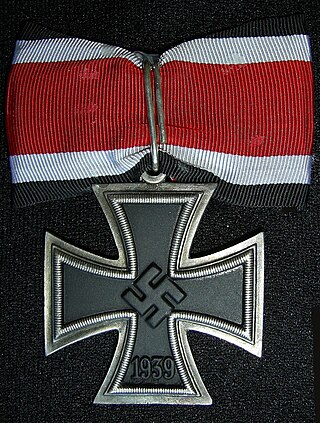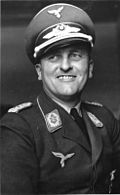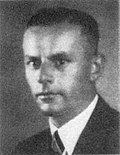Top Qs
Timeline
Chat
Perspective
List of Knight's Cross of the Iron Cross recipients (Kn–Kz)
From Wikipedia, the free encyclopedia
Remove ads
Remove ads
The Knight's Cross of the Iron Cross (German: Ritterkreuz des Eisernen Kreuzes) and its variants were the highest awards in the military and paramilitary forces of Nazi Germany during World War II. The Knight's Cross of the Iron Cross was awarded for a wide range of reasons and across all ranks, from a senior commander for skilled leadership of his troops in battle to a low-ranking soldier for a single act of extreme gallantry.[1] A total of 7,321 awards were made between its first presentation on 30 September 1939 and its last bestowal on 17 June 1945.[Note 1] This number is based on the analysis and acceptance of the Order Commission of the Association of Knight's Cross Recipients (AKCR). Presentations were made to members of the three military branches of the Wehrmacht—the Heer (army), Kriegsmarine (Navy) and Luftwaffe (air force)—as well as the Waffen-SS, the Reichsarbeitsdienst (RAD—Reich Labour Service) and the Volkssturm (German national militia). There were also 43 foreign recipients of the award.[3]
These recipients are listed in the 1986 edition of Walther-Peer Fellgiebel's book, Die Träger des Ritterkreuzes des Eisernen Kreuzes 1939–1945 [The Bearers of the Knight's Cross of the Iron Cross 1939–1945]. Fellgiebel was the former chairman and head of the order commission of the AKCR. In 1996, the second edition of this book was published with an addendum delisting 11 of these original recipients. Author Veit Scherzer has cast doubt on a further 193 of these listings. The majority of the disputed recipients had been nominated for the award in 1945, when the deteriorating situation of Germany during the final days of World War II left a number of nominations incomplete and pending in various stages of the approval process.[4]
Listed here are the 428 Knight's Cross recipients of the Wehrmacht and Waffen-SS whose last name is in the range "Kn–Kz".[5] Fellgiebel himself delisted one and Scherzer has challenged the validity of eight more of these listings.[6][7] This is the second of two lists of all 717 Knight's Cross of the Iron Cross recipients whose last name starts with "K". The recipients whose last name is in the range "Ka–Km" are listed at List of Knight's Cross of the Iron Cross recipients (Ka–Km).[8] The recipients are initially ordered alphabetically by last name. The rank listed is the recipient's rank at the time the Knight's Cross was awarded.
Remove ads
Background
Summarize
Perspective
The Knight's Cross of the Iron Cross and its higher grades were based on four separate enactments. The first enactment, Reichsgesetzblatt I S. 1573 of 1 September 1939 instituted the Iron Cross (Eisernes Kreuz), the Knight's Cross of the Iron Cross and the Grand Cross of the Iron Cross (Großkreuz des Eisernen Kreuzes). Article 2 of the enactment mandated that the award of a higher class be preceded by the award of all preceding classes.[9] As the war progressed, some of the recipients of the Knight's Cross distinguished themselves further and a higher grade, the Knight's Cross of the Iron Cross with Oak Leaves (Ritterkreuz des Eisernen Kreuzes mit Eichenlaub), was instituted. The Oak Leaves, as they were commonly referred to, were based on the enactment Reichsgesetzblatt I S. 849 of 3 June 1940.[10] In 1941, two higher grades of the Knight's Cross were instituted. The enactment Reichsgesetzblatt I S. 613 of 28 September 1941 introduced the Knight's Cross of the Iron Cross with Oak Leaves and Swords (Ritterkreuz des Eisernen Kreuzes mit Eichenlaub und Schwertern) and the Knight's Cross of the Iron Cross with Oak Leaves, Swords and Diamonds (Ritterkreuz des Eisernen Kreuzes mit Eichenlaub, Schwertern und Brillanten).[11] At the end of 1944 the final grade, the Knight's Cross of the Iron Cross with Golden Oak Leaves, Swords, and Diamonds (Ritterkreuz des Eisernen Kreuzes mit goldenem Eichenlaub, Schwertern und Brillanten), based on the enactment Reichsgesetzblatt 1945 I S. 11 of 29 December 1944, became the final variant of the Knight's Cross authorized.[12]
Remove ads
Recipients
Summarize
Perspective
The Oberkommando der Wehrmacht (Supreme Command of the Armed Forces) kept separate Knight's Cross lists, one for each of the three military branches, Heer (Army), Kriegsmarine (Navy), Luftwaffe (Air Force) and for the Waffen-SS. Within each of these lists a unique sequential number was assigned to each recipient. The same numbering paradigm was applied to the higher grades of the Knight's Cross, one list per grade.[13] Of the 428 awards made to servicemen whose last name is in the range "Kn–Kz", 43 were later awarded the Knight's Cross of the Iron Cross with Oak Leaves and nine the Knight's Cross of the Iron Cross with Oak Leaves and Swords; 38 presentations were made posthumously. Heer members, including the RAD, received 293 of the medals; 16 went to the Kriegsmarine, 96 to the Luftwaffe, and 23 to the Waffen-SS.[5] The sequential numbers greater than 843 for the Knight's Cross of the Iron Cross with Oak Leaves are unofficial and were assigned by the Association of Knight's Cross Recipients (AKCR) and are therefore denoted in parentheses.[14]
This along with the + (plus) indicates that a higher grade of Knight's Cross was awarded as well.
This along with the * (asterisk) indicates that the Knight's Cross was awarded posthumously.
This along with the ! (exclamation mark) indicates that author Walther-Peer Fellgiebel has expressed doubt regarding the veracity and formal correctness of the listing.
This along with the ? (question mark) indicates that author Veit Scherzer has expressed doubt regarding the veracity and formal correctness of the listing.
Remove ads
Notes
- Großadmiral and President of Germany Karl Dönitz, Hitler's successor as Head of State (Staatsoberhaupt) and Supreme Commander of the Armed Forces, had ordered the cessation of all promotions and awards as of 11 May 1945 (Dönitz-decree). Consequently the last Knight's Cross awarded to Oberleutnant zur See of the Reserves Georg-Wolfgang Feller on 17 June 1945 must therefore be considered a de facto but not de jure hand-out.[2]
- For an explanation of the various naming schemes used by the Luftwaffe, Heer, Kriegsmarine and Waffen-SS refer to nomenclature used by the Wehrmacht and Waffen-SS.
- According to Scherzer as Staffelkapitän of the Aufklärungsstaffel 3.(F)/121.[17]
- According to Scherzer as commander of Kampfgruppe "Sonnenstuhl" [an alarm unit with the II. SS-Panzerkorps, in the battle area of Arnhem/Netherlands].[17]
- According to Scherzer as commander of Feld-Ersatz-Regiment Panzer AOK 3.[20]
- Rudolf von Knebel-Doeberitz's original nomination for the Knight's Cross by his unit was either lost or not forwarded due to the military situation. A second nomination was made after the evacuation of East Prussia and the capitulation of Germany. This nomination was never processed. The order commission of the Association of Knight's Cross Recipients (AKCR) handled this case in 1982 and decided: "Knight's Cross yes, 8 May 1945". The presentation date was later changed by Walther-Peer Fellgiebel.[21]
- According to Scherzer as commander of the Fliegerhorst (airfield) Wiesbaden, leader of the Alarmeinheit (emergency unit) in area of Wiesbaden near Remagen.[25]
- According to Scherzer as Geschwaderkommodore of Lehrgeschwader 1.[25]
- No evidence of the award can be found in the German Federal Archives. The award was unlawfully presented by SS-Oberstgruppenführer Sepp Dietrich. The date is taken from the announcement made by the 6. SS-Panzerarmee.[21]
- According to Scherzer as leader of a Kampfgruppe of Grenadier-Regiment 50 in the fortress Posen [presumably a "Gneisenau-Einheit" of Wehrkreis III].[28]
- According to Scherzer as General der Infanterie.[28]
- According to Scherzer as commander of Luftlande-Sturm-Abteilung "Koch".[28]
- Walter Koehler's nomination by his unit was sent to the Heerespersonalamt (HPA—Army Staff Office) as a teleprinter message on 15 May 1945. The HPA received this message on 16 May 1945. Major Joachim Domaschk noted "not processed". The presentation date is an assumption of the Association of Knight's Cross Recipients (AKCR).[32]
- According to Scherzer as commander of the III./Regiment 4 "Brandenburg".[33]
- According to Scherzer as Staffelkapitän of the 3./Jagdgeschwader 11.[33]
- According to Scherzer as pilot in the 8./Jagdgeschwader 52.[35]
- According to Scherzer as pilot in the I./Jagdgeschwader 27.[36]
- According to Scherzer as Oberleutnant of the Reserves.[36]
- Walter Körner's nomination by his unit was received by the Heerespersonalamt (HPA—Army Staff Office) end of March 1945. There is no entry date listed on the file card nor in the book "Verliehene Ritterkreuze" (Awarded Knight Crosses). The HPA created a nomination request with the number 4980, which does not exist anymore, and according to the file card was submitted for further processing on 4 April 1945. No further comments or notes indicate that the nomination was finalized. Mr Meentz of the German Federal Archives stated on 20 July 2004 that it cannot be verified that Körner received the Knight's Cross. Walther-Peer Fellgiebel assigned the presentation date. Krätschmer claims that the award was approved on 9 May 1945.[32]
- According to Scherzer as pilot in the I./Schlachtgeschwader 2 "Immelmann".[36]
- The brackets around the doctor title [Dr.] denotes that the academic title was attained after the Knight's Cross of the Iron Cross was awarded.
- Ewald Koj's nomination by his unit was received by the Heerespersonalamt (HPA—Army Staff Office) on 15 April 1945. Major Joachim Domaschk decided on 16 April: "Actions, even if posthumously, do not justify presentation of the Knight's Cross." A Heerespersonalamt-Verleihungsvorschlag (HPA-VV—Army Staff Office Nomination Recommendation) Nr. 5077 was created on 18 April and then forwarded, indicating that the nomination had been rejected. No further information regarding the approval or presentation of the Knight's Cross is indicated. The book "Verliehene Ritterkreuze" (Awarded Knight Crosses) notes an entry date of 16 April and forwarded on 18 April. The presentation date was assigned by Walther-Peer Fellgiebel.[32]
- According to Scherzer as pilot in the 7./Nachtjagdgeschwader 4.[44]
- According to Scherzer as chief of the general staff of Luftflotte 3.[44]
- According to Scherzer as Oberleutnant of the Reserves.[45]
- Martin Kordemann's nomination by his unit was sent to the Heerespersonalamt (HPA—Army Staff Office) as a teleprinter message on 10 May 1945. Major Joachim Domaschk asked the Heeresgruppe C the date of action and the presentation date of the Iron Cross 1st class, which was answered on the same day. Major Domaschk approved the nomination and noted "Knight's Cross yes" without stating a date. There is no evidence of the presentation, which would anyhow have been illegal. The presentation date is an assumption of the Association of Knight's Cross Recipients (AKCR).[32]
- According to Scherzer as Ia (operations officer)/X. Fliegerkorps.[51]
- According to Scherzer as Oberleutnant.[55]
- According to Scherzer as pilot in the 7./Nachtjagdgeschwader 6.[55]
- According to Scherzer as leader of the 2./Hochgebirgsjäger-Bataillon 201, killed in action on 19 December 1944.[59]
- According to Scherzer as Oberleutnant of the Reserves.[61]
- The brackets around the professor and doctor title [Prof. Dr.] denotes that the academic title was attained after the Knight's Cross of the Iron Cross was awarded.
- No evidence of the award can be found in the German Federal Archives. The award was unlawfully presented by SS-Oberstgruppenführer Sepp Dietrich. The date is taken from the announcement made by the 6. SS-Panzerarmee. The sequential number "863" was assigned by the Association of Knight's Cross Recipients (AKCR). Karl Kreutz was member of the AKCR.[67]
- According to Scherzer as SS-Hauptsturmführer of the Reserves and commander of the III./SS-Freiwilligen-Gebirgsjäger-Regiment 14.[71]
- According to Scherzer as leader of the Flak-Abteilung SS-"Totenkopf"-Division.[71]
- According to Scherzer as Major assigned to General Staff training with Stab/321. Infanterie-Division and leader of a Kampfgruppe of the 321. Infanterie-Division.[73]
- According to Scherzer as radio/wireless operator in the Stab/Nachtjagdgeschwader 3.[78]
- Jakob Kuchar's nomination by his unit was received by the Heerespersonalamt (HPA—Army Staff Office) on 11 April 1945. Major approved the nomination on 12 April 1945. A Heerespersonalamt-Verleihungsvorschlag (HPA-VV—Army Staff Office Nomination Recommendation) Nr. 5085 was created on 19 April. According to the file card, this HPA-VV was forwarded for approval. No further information regarding the approval or presentation of the Knight's Cross is indicated. The presentation date is an assumption of the Association of Knight's Cross Recipients (AKCR).[67]
- According to Scherzer as Oberstleutnant of the Reserves.[78]
- According to Scherzer as Staffelkapitän of the Wettererkundungsstaffel 26.[82]
- According to Scherzer as pilot in the I./Sturzkampfgeschwader 2 "Immelmann".[82]
- According to Scherzer as Oberleutnant of the Reserves.[83]
- No evidence of the award can be found in the German Federal Archives. The award was unlawfully presented by the commanding general of the I Parachute Corps, General der Fallschirmtruppe Richard Heidrich.[67]
- According to Scherzer as observer in the 8./Kampfgeschwader 26.[89]
- According to Scherzer as Staffelkapitän of the Aufklärungsstaffel 1.(F)/Nacht.[90]
- According to Scherzer as Leutnant (war officer) and pilot in the 6./Zerstörergeschwader 1.[92]
- According to Scherzer as Oberfeldwebel.[92]
Remove ads
References
External links
Wikiwand - on
Seamless Wikipedia browsing. On steroids.
Remove ads







































